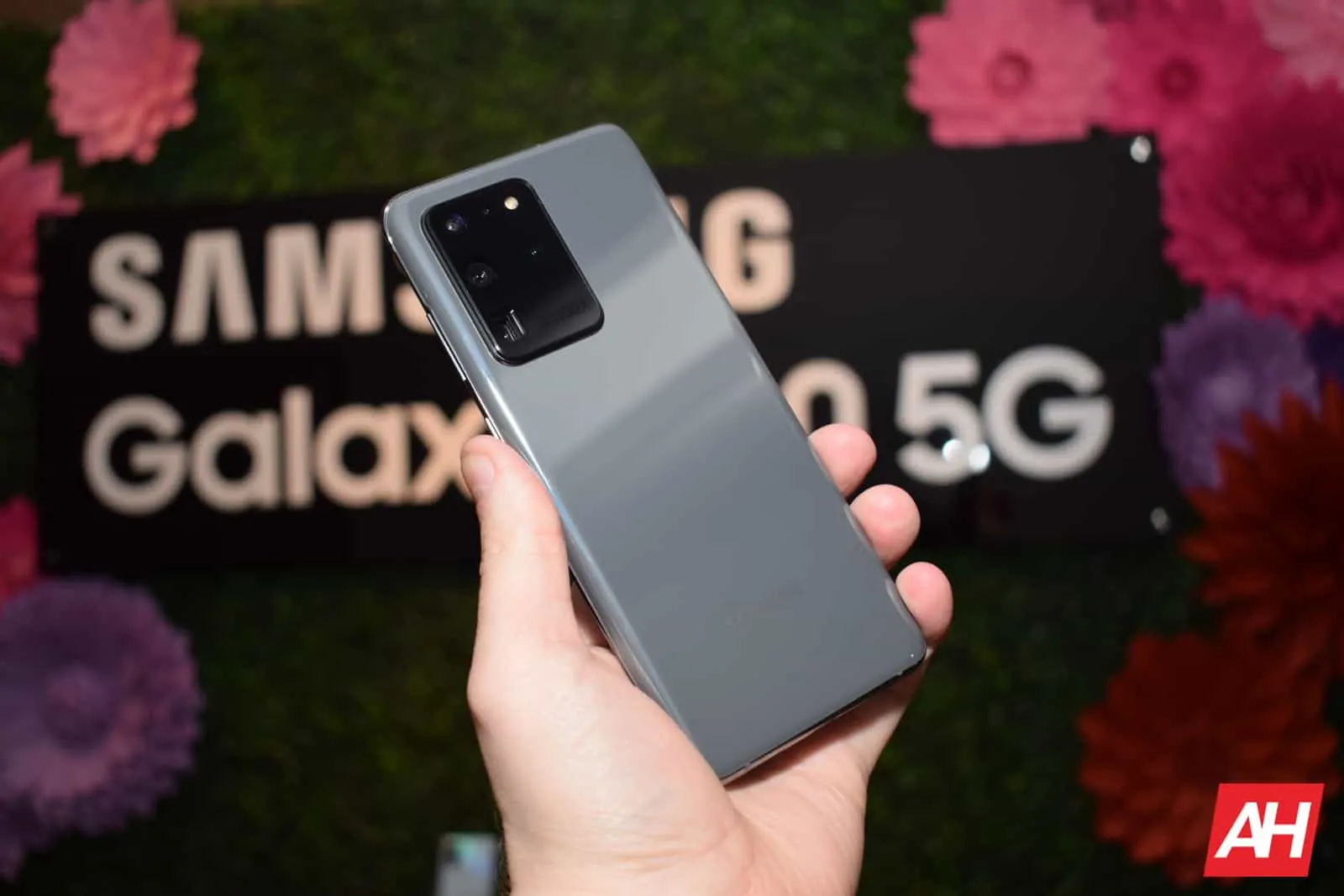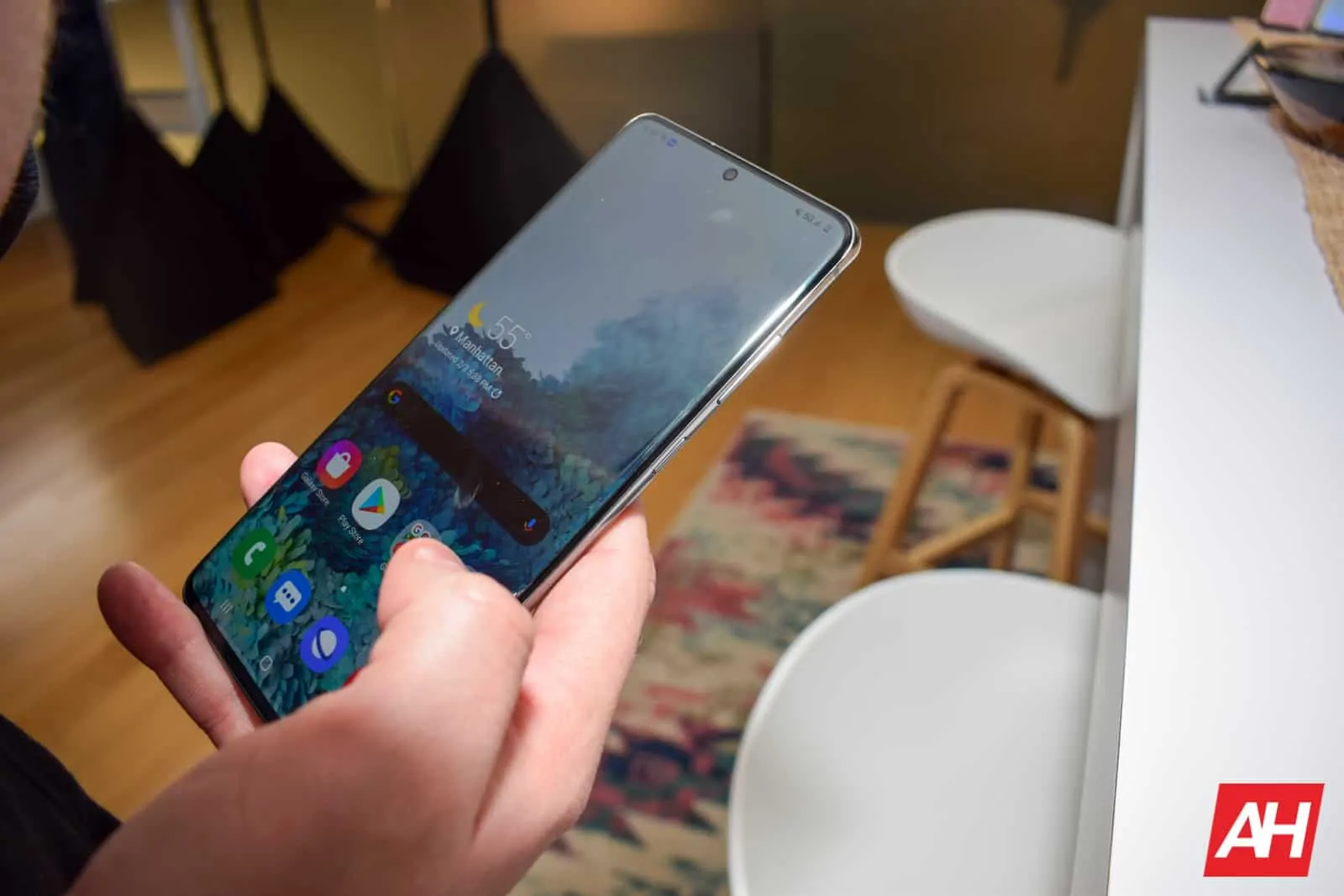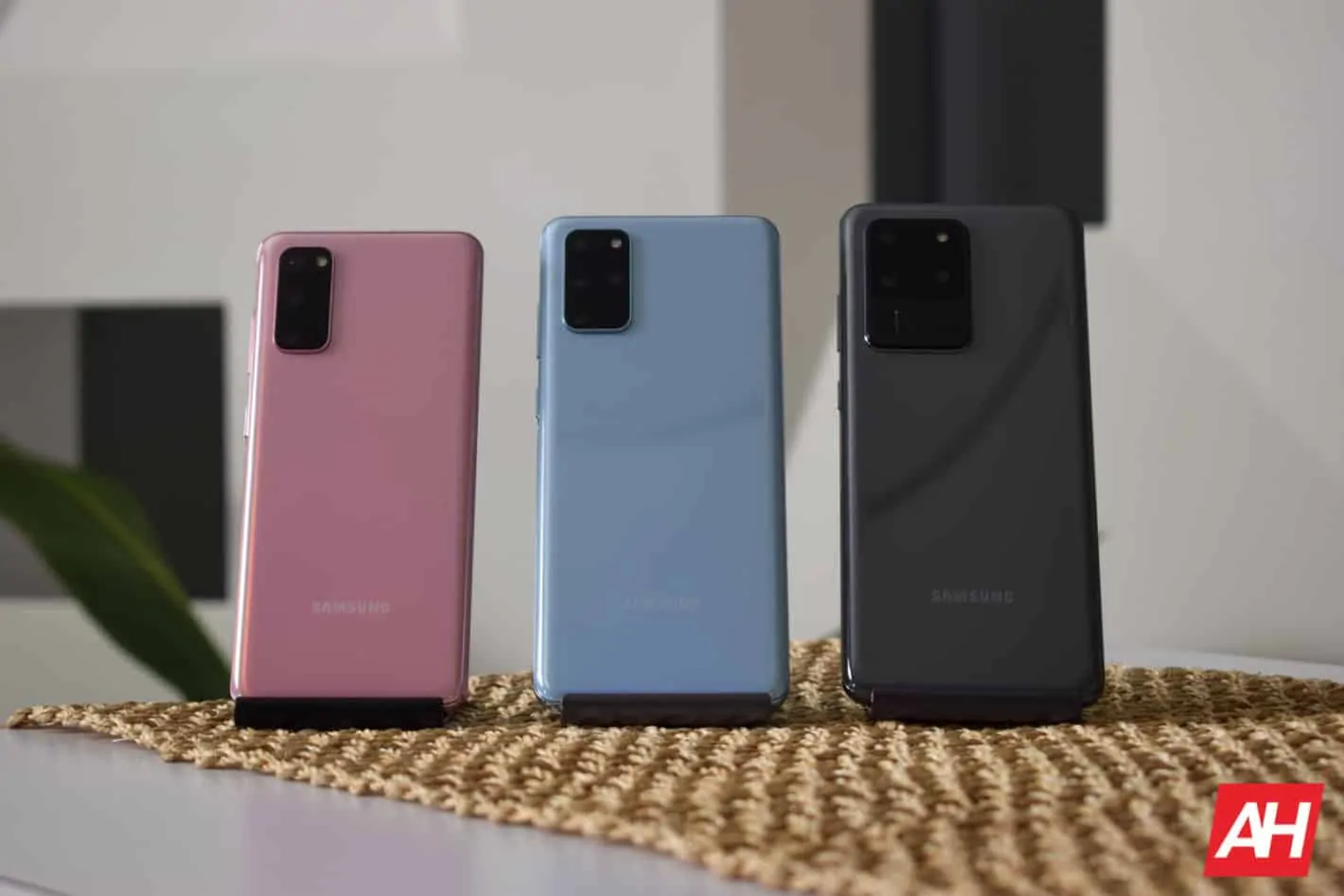Samsung had announced its Galaxy S20 series handsets earlier today. The company introduced the Galaxy S20, S20+, and S20 Ultra as part of this series, and we’re here to compare those three smartphones, to pit the Galaxy S20 vs Galaxy S20+, and the ‘Ultra’ model.
In this comparison, we’ll first compare the specs of the Galaxy S20 smartphones, and then move to other sections, including display, performance, and so on. We’ve had the chance to use all three phones before they got announced, which gave us a good idea of what you can expect out of these devices.
Each of these three devices is aimed for different types of consumers, mainly due to their size and price tag. There are some other differences between the phones, of course, which we’ll cover here. That being said, let’s get to it, shall we.
Samsung Galaxy S20 vs S20+ vs 20 Ultra: Specs
| Samsung Galaxy S20 | Samsung Galaxy S20+ | Samsung Galaxy S20 Ultra | |
| Screen size | 6.2-inch WQHD+ Dynamic AMOLED display (120Hz) | 6.7-inch WQHD+ Dynamic AMOLED display (120Hz) | 6.9-inch WQHD+ Dynamic AMOLED display (120Hz) |
| Screen resolution | 3200 x 1440 | 3200 x 1440 | 3200 x 1440 |
| SoC | Qualcomm Snapdragon 865 / Samsung Exynos 990 | Qualcomm Snapdragon 865 / Samsung Exynos 990 | Qualcomm Snapdragon 865 / Samsung Exynos 990 |
| RAM | 8GB / 12GB | 8GB / 12GB | 12GB/16GB |
| Storage | 128GB; Expandable up to 1TB | 128GB; Expandable up to 1TB | 128GB/512GB; Expandable up to 1TB |
| Rear cameras | 12MP (f/1.8 aperture, 79-degree angle lens) 64MP (f/2.0 aperture, 76-degree angle lens) 12MP(f/2.2 aperture, ultrawide 120-degree lens) |
12MP (f/1.8 aperture, 79-degree angle lens) 64MP (f/2.0 aperture, 76-degree angle lens) 12MP(f/2.2 aperture, ultrawide 120-degree lens) Depth Vision (ToF camera) |
108MP (f/1.8 aperture, 79-degree angle lens, wide-angle) 48MP (f/3.5 aperture, 24-degree angle lens) 12MP(f/2.2 aperture, 120-degree angle lens, ultrawide) Depth Vision (ToF camera) |
| Front cameras | 10MP (f/2.2 aperture, 80-degree angle lens) | 10MP (f/2.2 aperture, 80-degree angle lens) | 40MP (f/2.2 aperture, 80-degree angle lens) |
| Battery | 4,000mAh, non-removable, 25W fast battery charging, fast wireless charging, reverse charging | 4,500mAh, non-removable, 25W fast battery charging, fast wireless charging, reverse charging | 5,000mAh, non-removable, 45W fast battery charging, fast wireless charging, reverse charging |
| Dimensions | 152 x 68 x 7.9mm | 162 x 74 x 7.8mm | 167 x 76 x 8.8mm |
| Weight | 164 grams | 188 grams | 221 grams |
| Connectivity | LTE, 5G, NFC, Bluetooth 5.0, Wi-Fi, USB Type-C | LTE, 5G, NFC, Bluetooth 5.0, Wi-Fi, USB Type-C | LTE, 5G, NFC, Bluetooth 5.0, Wi-Fi, USB Type-C |
| Security | In-display fingerprint scanner (ultrasonic) | In-display fingerprint scanner (ultrasonic) | In-display fingerprint scanner (ultrasonic) |
| OS | Android 10 Samsung One UI 2 |
Android 10 Samsung One UI 2 |
Android 10 Samsung One UI 2 |
| Price | $999 | $1,199 | $1,399 / $1,699 |
| Buy | Samsung | Samsung | Samsung |
Do note that the 8GB RAM variants are not available in the US. The same goes for the Exynos 990 SoC.
Samsung Galaxy S20 vs S20+ vs 20 Ultra: Design
These three phones are quite similar in terms of design. From the front, they look almost identical. They are different in size, of course, but the overall look is almost the same. One difference that you’ll notice is the display curvature. The Galaxy S20’s display is the least curved, then goes the S20+, and then the S20 Ultra with the most curved panel. That is really difficult to notice, as the difference is not that big.
All three phones have a centered display camera hole on the front, and that hole is quite small, actually. All of them offer rounded corners, and the same goes for display corners. All physical keys are placed on the right-hand side of the Galaxy S20 series, while bezels are truly minimal on all phones.
From the back, the difference between phones is more apparent. The Galaxy S20 Ultra has, by far, the largest camera module. It takes up quite a bit of the top-left corner, and there’s a good reason for it, which we’ll talk more about in the camera section. The Galaxy S20+’s camera module is noticeably smaller, while the one on the S20 is the smallest. All three camera modules protrude on the back, though.
All three of these phones are quite slippery, so keep that in mind. That is not surprising, though, as they have glass backs. Now, one notable difference in their build comes down to their frame. The Galaxy S20 and S20+ come with a frame made out of aluminum, while the S20 Ultra raises the bar with stainless steel. Stainless steel is sturdier than aluminum, but it’s also considerably heavier. That makes the S20 Ultra quite heavy, to be quite honest, so we wouldn’t say that it’s a major advantage, at all.
Winner: Tie
Samsung Galaxy S20 vs S20+ vs 20 Ultra: Display
As far as the display tech is concerned, there is no difference between these three phones. All three devices use Samsung’s newest Infinity-O Dynamic AMOLED panels. Those displays come with a hole for the camera which is centered at the top of the display itself. The camera hole in these displays is quite small, maybe even the smallest we’ve seen thus far. That is great from the user perspective, of course, as you won’t be as distracted by it.
The Galaxy S20, S20+, and S20 Ultra do not feature the same display sizes, though, of course. The S20 includes the smallest display, a 6.2-inch panel. The Galaxy S20+ sports a 6.7-inch display, while the Galaxy S20 Ultra comes with a 6.9-inch panel. All of these displays are curved, and all of them offer a maximum resolution of 3,200 x 1,440.
All three phones offer curved displays
All three panels are curved, but they don’t offer the same curvature. The Galaxy S20’s panel is the least curved one, followed by the Galaxy S20+. The Galaxy S20 Ultra has the most-curved display, but it’s still less curved than the Galaxy S10. Samsung apparently wanted to tone down on the curves, while many other OEMs are pushing ‘Waterfall’ displays with extreme curvature.
What of display quality? Well, all three displays are top notch, as you’d expect out of Samsung. They offer great contrast, extremely punchy colors, and are just bright and vivid all around. These are essentially the same panels but different in size, so they’re on the same playing field. The smaller the panel, the higher the PPI, but you won’t really notice the difference in terms of sharpness.
On top of everything, it is also worth saying that these are high refresh rate displays. We’re looking at 120Hz displays here, and you can really notice the difference when that setting is on. Everything seems considerably smoother, and after using this setting for a while, you’ll have a hard time moving to a 60Hz setting. Do note that you can use 120Hz only with a fullHD+ resolution setting, not WQHD one. So, you basically have to choose between resolution and refresh rate, though we’d suggest you go with the refresh rate. Many of you won’t be able to tell the difference between the top two resolution settings on this display, but will be able to notice the difference in the refresh rate.
Winner: Tie
Samsung Galaxy S20 vs S20+ vs 20 Ultra: Performance
All three of these smartphones are fueled by the same processor, and have the same displays with different resolutions. All of them come with the same amount of RAM, aside from the 16GB RAM variant of the S20 Ultra. So, the performance is the same, right? Well, yeah, pretty much, it would be odd if it wasn’t.
You really don’t have anything to worry about when it comes to performance. All three of these phones can chew threw anything you throw their way, without a problem whatsoever. That is the way it should be, as these are the newest flagship offerings from the world’s number one smartphone manufacturer.
The Galaxy S20 series smartphones were able to multitask extremely fast, app-opening was a piece of cake, and the same goes for gaming. Do note that we’ve been using the Snapdragon 865 variants of these phones, though, not the Exynos 990 models that are meant to be sold in India.
We did not notice any lagging or anything of the sort on these handsets, and that is not surprising at all. The newest version of Android in combination with top of the line specifications, and Samsung’s fairly optimized UI are a really good combination when it comes to the performance. Those high refresh rate displays are only adding more fuel to the fire, they make everything even smoother.
Winner: Tie
Samsung Galaxy S20 vs S20+ vs 20 Ultra: Battery
We did not have enough time with each of these phones in order to judge battery life properly. What we can say, is that Samsung put quite a bit of thought into battery life this time around. Truth be said, on previous Galaxy S series smartphones, in the last couple of years, battery life wasn’t great. It was actually quite far from it, especially on smaller models. Well, the company promises things are different with the Galaxy S20.
Three different smartphone sizes, three different battery capacities
The Galaxy S20, S20+, and S20 Ultra come with 4,000mAh, 4,500mAh, and 5,000mAh battery packs, respectively. They do include the same displays, but display sizes are not identical. The Galaxy S20 Ultra has the largest battery due to the largest display, it makes sense. Now, based on battery life, and display sizes, and the refresh rate, we don’t think battery life here will be earth-shattering, but we have high expectations.

While we were using the phones, battery life held up pretty well, even during gaming. We did not see any major difference in drops between the Galaxy S20, S20+, and S20 Ultra, in case you were wondering. The S20 Ultra is expected to offer more in terms of battery life than the other two phones, but not by much. If you revert back to the 60Hz refresh rate setting, you’ll get noticeably more battery during your day.
It is also worth saying that all three phones offer fast charging, fast wireless charging, and reverse wireless charging. The Galaxy S20 Ultra offers the fastest charging, though, at 45W (wired). All three phones ship with a 25W charging brick. We’ll go for the Galaxy S20 Ultra in the battery department, as it seems like it will offer a bit better battery life than its siblings, plus it offers faster charging.
Winner: Samsung Galaxy S20 Ultra
Samsung Galaxy S20 vs S20+ vs 20 Ultra: Cameras
Cameras on these phones are quite interesting. The Galaxy S20 series represents a huge bump in terms of camera tech for Samsung. The company has been using the same / similar sensors for cameras for a while now, and the time has come for a change. The Galaxy S20 and S20+ offer almost the same camera setup, while the Galaxy S20 Ultra differs quite a bit. Still, the two smaller Galaxy S20 units have plenty to offer as well.
The Galaxy S20 and S20+ both include a 12-megapixel main camera, accompanied by a 64-megapixel telephoto unit. A 12-megapixel ultra-wide camera is also included on the back of both devices. The Galaxy S20+ also offers a ToF (Time-of-Flight) sensor on the back. A 10-megapixel unit can be found on the front side of both phones. The Galaxy S20 Ultra, on the other hand, sports a 108-megapixel main camera. It also has a 48-megapixel telephoto unit, a 12-megapixel ultra-wide camera, and a ToF sensor on the back. A 40-megapixel camera is included on its front side.
Great details, excellent dynamic range
We shot quite a few camera samples during our time with the devices, and even in rather iffy conditions, they did a great job. We could not test them in all scenarios, but the details and dynamic range are spot on, on all three phones. As long as the lighting is proper, you won’t see any difference between the three devices, or very minimal. The Galaxy S20+ and S20 Ultra did a slightly better job when it comes to the bokeh effect, though.
We were also able to try out these cameras in conditions with dimmer lighting, and they also did a great job. The S20 Ultra was a bit better than the other two, but not by much, to be quite honest. We did not get a chance to test them outside in low light conditions, but we’ll soon be able to. The Galaxy S20 Ultra offers a crazy 10x optical zoom, and 100x digital zoom, and it works similar as it did on the Huawei P30 Pro in terms of the results. In good lighting, this camera can be extremely useful.
The Galaxy S20 Ultra’s 108-megapixel camera uses some crazy pixel binning to make images look better, and it does a great job at that. When looking at the pics side-by-side, you can notice the difference, it does a slightly better job than the other two phones. All three are truly great performers in this aspect though. Still, we have to give this one to the ‘Ultra’.
Winner: Samsung Galaxy S20 Ultra
Samsung Galaxy S20 vs S20+ vs 20 Ultra: Audio
What about audio? Well, all three phones are identical in this regard, completely. They have the exact same audio setup. On the bottom of each phone, you’ll find their main speaker. Below the speaker grille on the front, lies the second one. Those two speakers create a really nice stereo sound effect, and are tuned by AKG. Dolby Atmos sound is supported, and it shows.
The performance is exactly the same, and that’s a good thing, as you’ll get some really nice sound out of these speakers. Distortion is minimal at high levels, while the sound is good across the board. It’s definitely one of the best in the market at the moment, and the same can be said for the sound through headphones as well.
Neither of these phones offers a 3.5mm headphone jack, but if you hook up a decent pair of headphones through a Type-C port, or Bluetooth, you’ll be able to enjoy quality music. Samsung was always good when it comes to audio, and it takes things a step up with the Galaxy S20. Output was really good, at all volume levels.
Winner: Tie
The overall winner
| Samsung Galaxy S20 | Samsung Galaxy S20+ | Samsung Galaxy S20 Ultra | |
| Design | ✓ | ✓ | ✓ |
| Display | ✓ | ✓ | ✓ |
| Performance | ✓ | ✓ | ✓ |
| Battery | ✓ | ||
| Cameras | ✓ | ||
| Audio | ✓ | ✓ | ✓ |
So, the Samsung Galaxy S20 Ultra is the winner of this comparison, technically. The device does have a slight advantage in the battery and camera departments, but… the other two phones are almost on par in both those sections. In all other categories, these three phones are pretty much the same, to be quite honest. They have the same displays, but different in size, they offer the same performance, software, and audio.

When choosing which phone to get, you need to consider their size and price tag, first and foremost. The Galaxy S20 is not cheap, but the Galaxy S20 Ultra is considerably more expensive. So, see what’s in your budget, if everything is, then choose the phone that fits you best in terms of size. The Galaxy S20 is by far the most compact one, and best for one-handed use. It still has a rather large 6.2-inch display, though, so… it all depends on what you prefer.
Winner: Samsung Galaxy S20 Ultra

